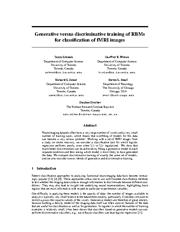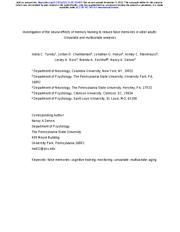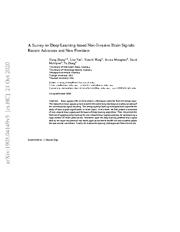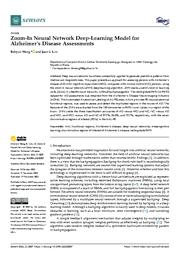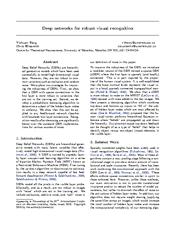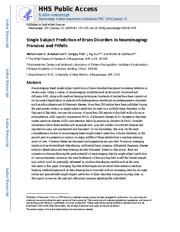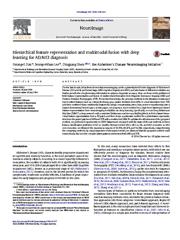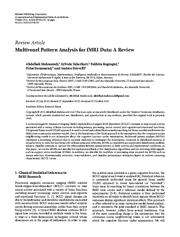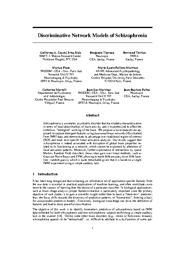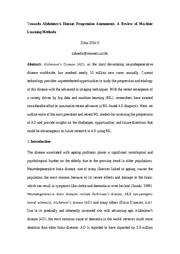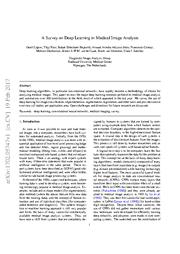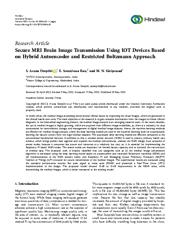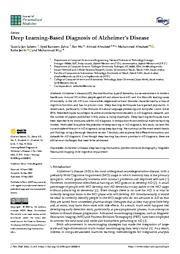A copy of this work was available on the public web and has been preserved in the Wayback Machine. The capture dates from 2021; you can also visit the original URL.
The file type is application/pdf.
Filters
Generative versus discriminative training of RBMs for classification of fMRI images
2008
Neural Information Processing Systems
Working with a set of fMRI images from a study on stroke recovery, we consider a classification task for which logistic regression performs poorly, even when L1-or L2-regularized. ...
We compare discriminative training of exactly the same set of models, and we also consider convex blends of generative and discriminative training. ...
Acknowledgments We thank Natasa Kovacevic for co-registering and motion-correcting the fMRI data used in this study. ...
dblp:conf/nips/SchmahHZSS08
fatcat:glsagaci25hljltqbanbuz5q4i
Investigation of the neural effects of memory training to reduce false memories in older adults: Univariate and multivariate analyses
[article]
2022
bioRxiv
pre-print
Collectively, our results highlight the benefits of training for reductions of false memories in aging. They also provide an understanding of the neural mechanisms that support these reductions. ...
We examined the neural basis of a retrieval-based monitoring strategy by assessing changes in univariate BOLD activity and discriminability of targets and lures pre and post training. ...
We thank the Penn State Social, Life, & Engineering Sciences Imaging Center (SLEIC) 3T MRI Facility. ...
doi:10.1101/2022.11.08.515495
fatcat:wbci7wnurfavvlfiyjzypei4sa
A Survey on Deep Learning-based Non-Invasive Brain Signals:Recent Advances and New Frontiers
[article]
2020
arXiv
pre-print
We then present a comprehensive survey of deep learning techniques used for BCI, by summarizing over 230 contributions most published in the past five years. ...
Deep learning has lifted the performance of brain-computer interface systems significantly in recent years. ...
For instance, we can build the GAN by convolutional layers on fMRI images since CNN has an excellent ability to extract spatial features. The discriminator and the generator are trained jointly. ...
arXiv:1905.04149v5
fatcat:sjz3wvw5vvch3ncxnvflgbob3a
Recent advances of deep learning in psychiatric disorders
2020
Precision Clinical Medicine
We conclude our review by clarifying the main promises and challenges of DL application in psychiatric disorders, and possible directions for future research. ...
The results of these studies indicate that DL could be a powerful tool in assisting the diagnosis of psychiatric diseases. ...
Acknowledgements This work was supported by National Natural Science Foundation of China (Grant No. 91859203) and Young Elite Scientists Sponsorship Program by CAST (YESS20160060). ...
doi:10.1093/pcmedi/pbaa029
pmid:35694413
pmcid:PMC8982596
fatcat:46k3vpw65ndnzcslne4a5fznem
Zoom-In Neural Network Deep-Learning Model for Alzheimer's Disease Assessments
2022
Sensors
ZNN yields the three classification accuracies of AD versus MCI and NC, NC versus AD and MCI, and MCI versus AD and NC of 97.7%, 84.8%, and 72.7%, respectively, with the seven discriminative regions of ...
The resting-state fMRI (rs-fMRI) dataset for AD assessments was obtained from the Alzheimer's Disease Neuroimaging Initiative (ADNI). ...
Conflicts of Interest: The authors declare no conflict of interest. Sensors 2022, 22, 8887 ...
doi:10.3390/s22228887
pmid:36433486
pmcid:PMC9694235
fatcat:fsnhitejp5d3rnhqlovou3bmga
Deep networks for robust visual recognition
2010
International Conference on Machine Learning
We explore two strategies for improving the robustness of DBNs. First, we show that a DBN with sparse connections in the first layer is more robust to variations that are not in the training set. ...
Recognition results after denoising are significantly better over the standard DBN implementations for various sources of noise. ...
Acknowledgements We thank the anonymous reviewers for making this a much better manuscript. This research was supported by NSERC. ...
dblp:conf/icml/TangE10
fatcat:xxncjb4amndi7pnwpdy4z6j4ra
Deep learning applications for the classification of psychiatric disorders using neuroimaging data: systematic review and meta-analysis
[article]
2020
medRxiv
pre-print
These results suggest that deep learning of neuroimaging data is a promising tool for the classification of individual psychiatric patients. ...
Thirty-two of the thirty-five studies that directly compared DL to ML reported a higher accuracy for DL. ...
One other study by Sen et al. (2018) 16 developed a general model for
of Matsubara et al. (2015) 18 developed a general model for classification of fMRI and tested this for both schizophrenia and bipolar ...
doi:10.1101/2020.06.12.20129130
fatcat:4uppkakshnedhgdvdxipzepbbq
Single subject prediction of brain disorders in neuroimaging: Promises and pitfalls
2017
NeuroImage
Using a variety of neuroimaging modalities such as structural, functional and diffusion MRI, along with machine learning techniques, hundreds of studies have been carried out for accurate classification ...
Moreover, emerging trends such as decentralized data sharing, multimodal brain imaging, differential diagnosis, disease subtype classification and deep learning are also discussed. ...
Sui); Chinese National Science Foundation No. 81471367 and the State High-Tech Development Plan (863) No. 2015AA020513; Also, we would like to thank Monica Jaramillo for the initial survey of neuroimaging ...
doi:10.1016/j.neuroimage.2016.02.079
pmid:27012503
pmcid:PMC5031516
fatcat:7kxm7yeugrgvdlxmitccneqxc4
Hierarchical feature representation and multimodal fusion with deep learning for AD/MCI diagnosis
2014
NeuroImage
In three binary classification problems of AD vs. healthy Normal Control (NC), MCI vs. NC, and MCI converter vs. ...
Here, we focus on the problems of both feature representation and fusion of multimodal information from Magnetic Resonance Imaging (MRI) and Positron Emission Tomography (PET). ...
Unlike the conventional generative DBM, in this work, we consider a discriminative DBM, by injecting a discriminative RBM (Larochelle and Bengio, 2008) at the top hidden layer. ...
doi:10.1016/j.neuroimage.2014.06.077
pmid:25042445
pmcid:PMC4165842
fatcat:5cfxrvzalvdhhj3ccztwtkq5uu
Multivoxel Pattern Analysis for fMRI Data: A Review
2012
Computational and Mathematical Methods in Medicine
In this paper , we review MVPA and describe the mathematical basis of the classification algorithms used for decoding fMRI signals, such as support vector machines (SVMs). ...
The general linear model (GLM) approach is used to reveal task-related brain areas by searching for linear correlations between the fMRI time course and a reference model. ...
RFE has been recently used for the analysis of fMRI data and has been proven to improve generalization performances in discriminating visual stimuli during two different tasks [31, 46] . ...
doi:10.1155/2012/961257
pmid:23401720
pmcid:PMC3529504
fatcat:7w5lpyxbinegvbsinzudvc4dey
Discriminative Network Models of Schizophrenia
2009
Neural Information Processing Systems
We propose a novel data-driven approach to capture emergent features using functional brain networks [4] extracted from fMRI data, and demonstrate its advantage over traditional region-of-interest (ROI ...
50% baseline -random guess), which is quite remarkable given that it is based on a single fMRI experiment using a simple auditory task. ...
Acknowledgements We would like to thank Rahul Garg for his help with the data preprocessing and many stimulating discussions that contributed to the ideas of this paper, and Drs. ...
dblp:conf/nips/CecchiRTTPPMMP09
fatcat:yv5iehq4tzafzkvluooiqwpeeq
Towards Alzheimer's Disease Progression Assessment: A Review of Machine Learning Methods
[article]
2022
arXiv
pre-print
Current technology provides unprecedented opportunities to study the progression and etiology of this disease with the advanced in imaging techniques. ...
Here, we outline some of the most prevalent and recent ML models for assessing the progression of AD and provide insights on the challenges, opportunities, and future directions that could be advantageous ...
In ML model training, the most common types of imaging data for classification studies include positron emission tomography (PET), magnetic resonance imaging (MRI) which include structural MRI (sMRI) and ...
arXiv:2211.02636v2
fatcat:bbpjixlbsjahpeci44zfiiquza
A survey on deep learning in medical image analysis
2017
Medical Image Analysis
We survey the use of deep learning for image classification, object detection, segmentation, registration, and other tasks and provide concise overviews of studies per application area. ...
Deep learning algorithms, in particular convolutional networks, have rapidly become a methodology of choice for analyzing medical images. ...
ArXiv was searched for papers mentioning one of a set of terms related to medical imaging. ...
doi:10.1016/j.media.2017.07.005
pmid:28778026
fatcat:esbj72ftwvbgzh6jgw367k73j4
Secure MRI Brain Image Transmission Using IOT Devices Based on Hybrid Autoencoder and Restricted Boltzmann Approach
2022
Journal of Sensors
machines (RBM) and (ii) implementation of the WSN sensors nodes with Raspberry Pi and Messaging Queue Telemetry Transport (MQTT) Internet of Things (IoT) protocol for secure transmission of the medical ...
In recent times, the medical image processing solves several clinical issues by inspecting the visual images, which are generated in the clinical health care units. ...
We have considered both the autoencoder [6] and RBM [7] as the compression techniques for medical images on the belief that they can be used to select the most discriminative features in an image in ...
doi:10.1155/2022/5841630
fatcat:fvz2x6ywbrdthfx5exp34c26ey
Deep Learning-Based Diagnosis of Alzheimer's Disease
2022
Journal of Personalized Medicine
The study also explores the different biomarkers and datasets for AD diagnosis. ...
Deep learning techniques have been reported to be more accurate for AD diagnosis in comparison to conventional machine learning models. ...
The authors utilized Convolutional Auto-Encoder for performing AD versus NC classification, and transfer learning was implemented to perform pMCI versus sMCI classification. ...
doi:10.3390/jpm12050815
pmid:35629237
pmcid:PMC9143671
fatcat:mpbhqnwivvh25pleezqsrjnm4a
« Previous
Showing results 1 — 15 out of 91 results

